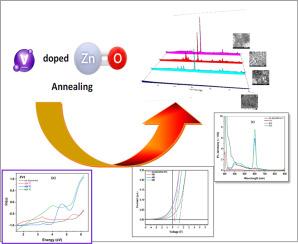Influence of annealing temperatures on the structural, optical and electrical properties of vanadium-doped ZnO thin films
IF 6.3
2区 材料科学
Q2 CHEMISTRY, PHYSICAL
引用次数: 0
Abstract
This study investigates the influence of annealing temperature on the structural, optical, and electrical properties of pure and vanadium (V)-doped zinc oxide (ZnO) thin films prepared by the sol–gel dip-coating method. Three compositions were examined: undoped ZnO (ZV0), 1% V-doped ZnO (ZV1), and 3% V-doped ZnO (ZV3). The films were annealed from the as-deposited state up to 600 °C and characterized using X-ray diffraction, UV–Visible spectroscopy, Fourier-transform infrared spectroscopy, photoluminescence, and current–voltage measurements. The crystallite size varied around 42-46 nm, while the optical band gap decreased with increasing annealing temperature lowest value was recorded 3.00 eV for ZV 3 at 400 °C. The Urbach energy ranged from 0.35 to 1.11 eV, reflecting changes in defect states. Electrical analysis revealed a significant reduction in threshold voltage, with the lowest value of 0.25 V observed for the ZV3 sample annealed at 400 °C. These results demonstrate that annealing strongly governs crystallinity, defect density, and charge transport, with ZV3 annealed at 400 °C showing the most promising performance for optoelectronic applications.

退火温度对掺钒ZnO薄膜结构、光学和电学性能的影响
本文研究了退火温度对溶胶-凝胶浸涂法制备纯氧化锌薄膜和掺杂钒氧化锌薄膜的结构、光学和电学性能的影响。研究了三种成分:未掺杂ZnO (z0)、1% v掺杂ZnO (ZV1)和3% v掺杂ZnO (ZV3)。将薄膜从沉积状态退火到600°C,并使用x射线衍射,紫外可见光谱,傅里叶变换红外光谱,光致发光和电流-电压测量对其进行表征。晶体尺寸在42 ~ 46 nm之间变化,光学带隙随退火温度的升高而减小,zv3在400℃时最小值为3.00 eV。Urbach能量在0.35 ~ 1.11 eV之间,反映了缺陷态的变化。电学分析显示,阈值电压显著降低,在400°C退火的ZV3样品中观察到的最低值为0.25 V。这些结果表明,退火对结晶度、缺陷密度和电荷输运有很强的控制作用,在400°C退火的ZV3在光电应用中表现出最有希望的性能。
本文章由计算机程序翻译,如有差异,请以英文原文为准。
求助全文
约1分钟内获得全文
求助全文
来源期刊

Surfaces and Interfaces
Chemistry-General Chemistry
CiteScore
8.50
自引率
6.50%
发文量
753
审稿时长
35 days
期刊介绍:
The aim of the journal is to provide a respectful outlet for ''sound science'' papers in all research areas on surfaces and interfaces. We define sound science papers as papers that describe new and well-executed research, but that do not necessarily provide brand new insights or are merely a description of research results.
Surfaces and Interfaces publishes research papers in all fields of surface science which may not always find the right home on first submission to our Elsevier sister journals (Applied Surface, Surface and Coatings Technology, Thin Solid Films)
 求助内容:
求助内容: 应助结果提醒方式:
应助结果提醒方式:


